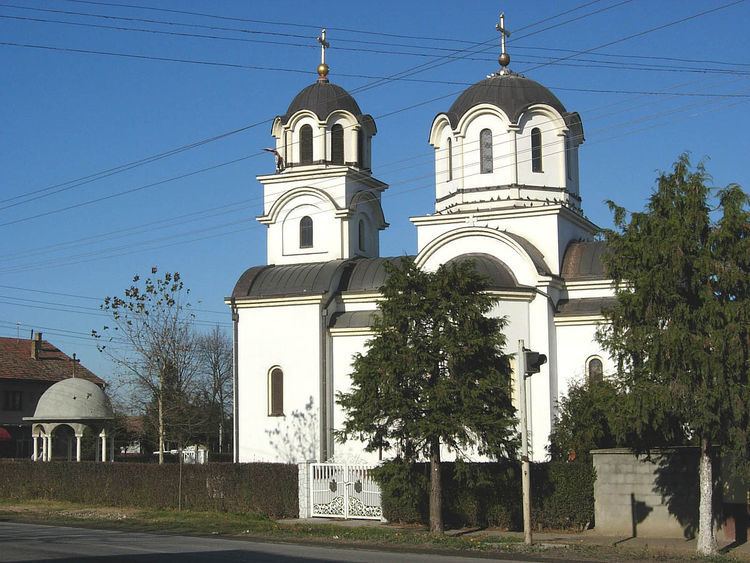Time zone CET (UTC+1) Local time Wednesday 10:38 PM | Population 3,428 (2002) | |
 | ||
Weather 11°C, Wind W at 13 km/h, 66% Humidity | ||
Hrtkovci (Serbian Cyrillic: Хртковци) is a village in Serbia. It is located in the Ruma municipality, in the Syrmia District, Vojvodina province. The village has a Serb ethnic majority and its population numbering 3,428 people (2002 census). According to previous census (from 1991), the village had a Croat ethnic majority and its population numbered 2,684 people.
Contents
- Map of Hrtkovci Serbia
- Name
- History
- 1991 census
- 2002 census
- Historical population of the village
- References
Map of Hrtkovci, Serbia
Name
In Serbian, the village is known as Hrtkovci (Хртковци), in Croatian as Hrtkovci, and in Hungarian as Herkóca.
History
Modern village was firstly mentioned in 1714, during Ottoman administration. There are assumptions that some older settlements existed at this locality. These settlements were probably villages named Gomol (recorded in 1353) and Hudrovecz (recorded in 1477).
Since 1718, the village was part of the Habsburg Monarchy. It was firstly included into the Kingdom of Slavonia and then into the Military Frontier (Petrovaradin regiment). In 1737, about 1,600 Catholic Albanians from Klimenti clan came to Srem. They were settled in the villages of Hrtkovci and Nikinci. Today, their descendants consider themselves Croats.
In 1848-1849, the village was part of autonomous Serbian Vojvodina, but was returned to the jurisdiction of the Military Frontier in 1849. After the abolishment of the frontier, in 1882, the village was included into the autonomous Habsburg Kingdom of Croatia-Slavonia, which was part of the Habsburg Kingdom of Hungary and Austria-Hungary. The village was administratively a part of the Ruma district within the Syrmia County. According to the etnographic map of the Austrian Monarchy, created by Karl Freiherrn von Czoernig and published in Wien in 1855, the village of Hrtkovci was predominately populated by ethnic Albanians.
According to 1910 census, the village was ethnically mixed and the largest linguistic group were the speakers of Croatian language (1,144). Other languages spoken in the village were German (644), Hungarian (619), Serbian (70), Slovak (20), etc.
In 1918, the village firstly became part of the State of Slovenes, Croats and Serbs, then part of the Kingdom of Serbia, and finally part of the Kingdom of Serbs, Croats and Slovenes (renamed to the Kingdom of Yugoslavia in 1929). From 1918 to 1922, the village was part of the Syrmia County, from 1922 to 1929 part of the Syrmia Oblast, and from 1929 to 1941, part of the Danube Banovina.
From 1941 to 1944, the village was under Axis occupation and was included into the Pavelić's Independent State of Croatia. Since 1944, the village was part of autonomous Yugoslav Vojvodina, which (from 1945) was part of new socialist Yugoslav Serbia.
Before the Yugoslav wars, the village was ethnically mixed and largest ethnic group in Hrtkovci were Croats, while the rest of population were Serbs, Hungarians and Yugoslavs. According to the ICTY indictment against Serbian Radical Party leader Vojislav Šešelj, he allegedly came to this village in May 1992 and gave an inflammatory speech calling for the expulsion of Croats from the area and reading a list of individual Croat residents who should leave for Croatia. As a result of this speech, a number of Croat resident decided to leave Hrtkovci. After this speech, supporters and associates of Vojislav Šešelj, including members of Serbian Radical Party and Serbian Chetnik Movement, allegedly began a campaign of harassment and intimidation of local Croats, forcing them to "leave" the area. In its indictment, the ICTY gave a list of 722 people who left Hrtkovci. (See also: Expulsions in Hrtkovci). The Prosecution in ICTY failed to prove the indictment against Šešelj and he was declared not guilty on all charges in March 2016.
Instead of Croats, Serb refugees from Croatia and Bosnia settled in the village. Most of the Croats from Hrtkovci moved to Croatia, and settled in the village of Kula near Požega, while many Serb refugees from that place settled in Hrtkovci.
1991 census
According to 1991 census, the population of the village numbered 2,684 people, including:
2002 census
According to 2002 census, the population of the village numbered 3,428 people, including:
